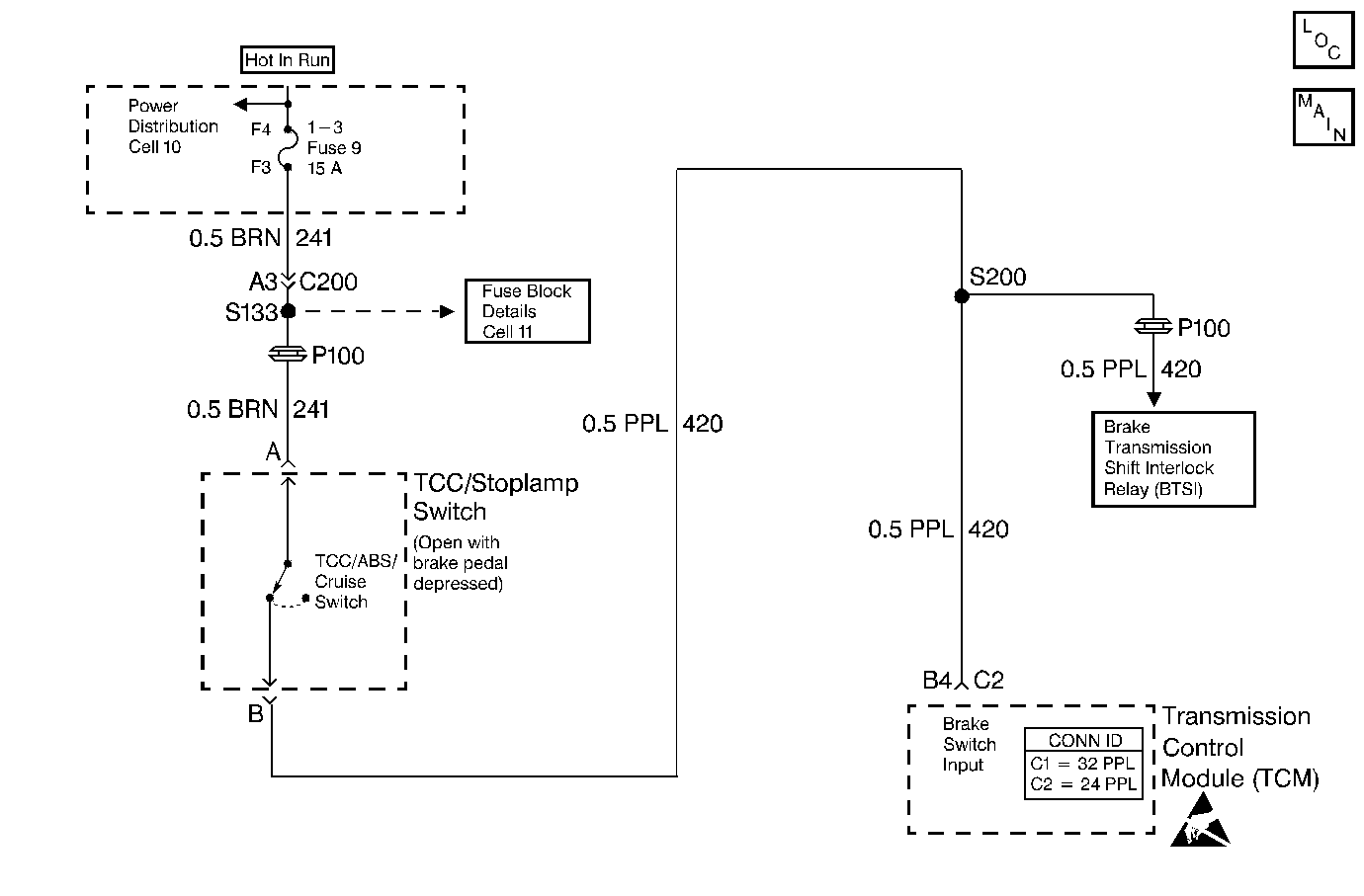DTC 37 TCC Brake Switch Low Input L57 MFI

Circuit Description
The TCC stoplamp switch indicates the brake pedal status. The normally-closed TCC stoplamp switch supplies a B+ signal on circuit 420 to the transmission control module (TCM). The signal voltage circuit opens when the brakes are applied. The TCM uses the open signal voltage circuit in order to de-energize the torque converter clutch pulse width modulation (TCC PWM) solenoid valve when the brakes are applied.
If the TCM detects an open TCC stoplamp switch circuit during accelerations, then DTC 37 sets.
Conditions for Running the DTC
The following sequence of events occurs:
| • | The vehicle speed is less than 8 km/h (5 mph) for 6 seconds. |
| • | Then vehicle speed is 8-40 km/h (5-25 mph) for 6 seconds. |
| • | Then the vehicle speed is greater than 40 km/h (25 mph) for 6 seconds. |
Conditions for Setting the DTC
| • | The TCM detects an open TCC stoplamp switch/circuit (0 volts). |
| • | All conditions are met for seven occurrences. |
Action Taken When the DTC Sets
| • | The TCM does not illuminate the malfunction indicator lamp (MIL). |
| • | The TCM inhibits TCC. |
| • | The TCM inhibits 4th gear if in hot mode. |
| • | The TCM stores DTC 37 in TCM history. |
Conditions for Clearing the DTC
| • | A scan tool clears the DTC from TCM history. |
| • | The TCM clears the DTC from TCM history if the vehicle completes 40 consecutive key cycles without a diagnostic fault occurring. |
| • | The TCM cancels the DTC default actions when the fault no longer exists and the ignition switch is OFF long enough in order to power down the TCM. |
Diagnostic Aids
| • | Inspect the wiring at the TCM, the TCC stoplamp switch and all other circuit connecting points for the following conditions: |
| - | A backed out terminal |
| - | A damaged terminal |
| - | Reduced terminal tension |
| - | A chafed wire |
| - | A broken wire inside the insulation |
| - | Moisture intrusion |
| - | Corrosion |
| • | When diagnosing for an intermittent short or open, massage the wiring harness while watching the test equipment for a change. |
| • | Ask about the customer's driving habits and any unusual driving conditions he or she might have, such as stop and go traffic or expressway driving. |
| • | Inspect the brake switch for proper mounting and adjustment. |
| • | Inspect for the most current calibration ID and the latest bulletins. |
Test Description
The numbers below refer to the step numbers on the diagnostic table.
-
This step tests for TCC stoplamp switch voltage to the TCM connector.
-
This step isolates the TCC stoplamp switch as a source for setting the DTC.
-
This step tests for a short to ground in circuit 241 (ignition voltage) to the TCC stoplamp switch.
-
This step tests for a short to ground in circuit 420, from the TCC stoplamp switch to the TCM.
-
This step isolates the TCM as a source for causing the fuse to open.
Step | Action | Value(s) | Yes | No | ||||||||||
|---|---|---|---|---|---|---|---|---|---|---|---|---|---|---|
1 | Was the Powertrain On-Board Diagnostic (OBD) System Check performed? | -- | ||||||||||||
2 |
Important:: Before clearing the DTCs, use the scan tool in order to record the Failure Records. Using the Clear Info function erases the Failure Records from the TCM. Does the Scan Tool TCC Brake Switch indicate CLOSED, when the brake pedal is not applied? | -- | Go to Diagnostic Aids | |||||||||||
3 |
Refer to General Electrical Diagnosis in Wiring Systems. Is the fuse open? | -- | ||||||||||||
Is the test lamp on? | -- | |||||||||||||
5 |
Is B+ voltage indicated? | 10.0-13.0 volts | ||||||||||||
6 | Inspect circuit 241 (BRN) for an open. Refer to General Electrical Diagnosis in Wiring Systems. Was a condition found? | -- | -- | |||||||||||
Is the test lamp on? | -- | |||||||||||||
8 | Inspect circuit 420 (PPL) for an open. Refer to General Electrical Diagnosis in Wiring Systems. Was a condition found? | -- | -- | |||||||||||
9 | Replace the TCC/stoplamp switch. Refer to Stoplamp Switch Replacement in Hydraulic Brakes. Is the replacement complete? | -- | -- | |||||||||||
Does the fuse open with the brake pedal applied? | -- | |||||||||||||
11 | Inspect circuit 241 (BRN) for a short to ground. Refer to General Electrical Diagnosis in Wiring Systems. Was a condition found? | -- | -- | |||||||||||
With the ignition switch in the RUN position, release the brake pedal. Does the fuse open when the brake pedal is released? | -- | Go to Diagnostic Aids | ||||||||||||
Does the fuse open? | -- | |||||||||||||
14 | Inspect circuit 420 (PPL) for a short to ground. Refer to General Electrical Diagnosis in Wiring Systems. Was a condition found? | -- | -- | |||||||||||
15 | Replace the TCM. Refer to Powertrain Control Module Replacement/Programming in Engine Controls. Is the replacement complete? | -- | -- | |||||||||||
16 | Repair the wiring as necessary. Refer to Wiring Repairs in Wiring Systems. Is the repair complete? | -- | -- | |||||||||||
17 | Perform the following procedure in order to verify the repair:
Does the TCC brake switch indicate CLOSED when the brake pedal is not applied, then indicate OPEN when the brake pedal is applied? | -- | System OK |
